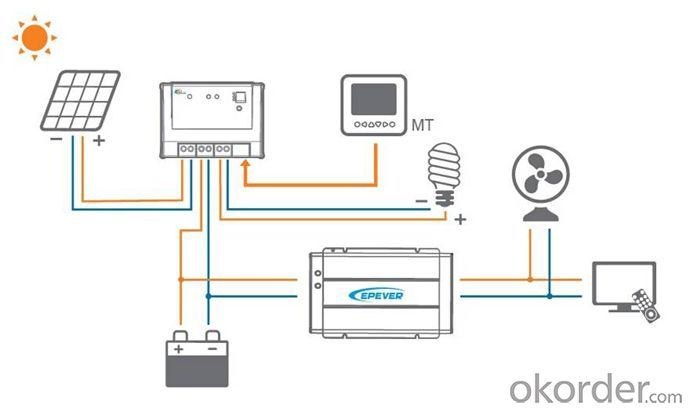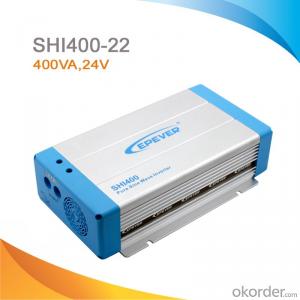Off-Grid Pure Sine Wave Solar Inverter/Power Inverter 400W, DC 24V to AC 220V/230V SHI400-22
- Loading Port:
- China Main Port
- Payment Terms:
- TT or LC
- Min Order Qty:
- -
- Supply Capability:
- -
OKorder Service Pledge
OKorder Financial Service
You Might Also Like
SHI series is a pure sine wave inverter which can convert 12/24/48Vdc to 220/230Vac 50/60Hz based on full digital and intelligent design. It features high reliability, high efficiency, concise outline, small volume, easy installation and operation. The inverter can be applied in many fields, such as household appliances, electric tools and industrial devices etc, especially for solar photovoltaic power system.
True sine wave inverters produce power that is either identical or sometimes slightly better to power from the public utility power grid system. The power wave when viewed through an oscilloscope is a smooth sine wave.
Features:
·Input & output fully isolation
·Adoption of advanced SPWM technology, pure sine wave output
·Dynamic current loop control technology to ensure inverter reliable operation
·Wide DC input voltage range
·The output voltage and frequency can be switched
·Low output harmonic distortion(THD≤3%)
·LED indicators for input voltage range, load power range, normal output & failure state
·Optional energy saving mode
·Wide working temperature range (industrial level)
·Continuous operation at full power
Protections:
·Output short circuit protection
·Overload protection
·Input low voltage protection
·Input over voltage protection
·Overheating protection
·Inverter abnormal protection

Specification:
Types | SHI400-12 | SHI400-22 | SHI600-12 | SHI600-22 | SHI1000-22 | SHI1000-42 |
Nominal Battery Voltage | 12V | 24V | 12V | 24V | 24V | 48V |
Input Voltage Range | 10.8~16Vdc | 21.6~32Vdc | 10.8~16Vdc | 21.6~32Vdc | 21.6~32Vdc | 43.2~64Vdc |
No Load Current | ≤0.8A | ≤0.45A | ≤0.7A | ≤0.45A | ≤0.45A | ≤0.35A |
Output Wave | Pure Sine Wave | |||||
Output Voltage | 220Vac±3% / 230Vac±10% | |||||
Continuous Power | 400W | 600W | 1000W | |||
Power 10 sec | 600W | 900W | 1500W | |||
Power 1.5 sec | 800W | 1200W | 2000W | |||
Surge Power | 900W | 1350W | 2250W | |||
Frequency | 50/60Hz±0.2% | |||||
Distortion THD | ≤ 3% (resistive load) | |||||
Efficiency at Rated Power | ≥91% | ≥92% | ≥91% | ≥92% | ≥93% | ≥93.5% |
Max. Efficiency | ≥92% | ≥93% | ≥93% | ≥94% | ≥94% | ≥94% |
Terminal | 16mm2 | 25mm2 | 25mm2 | |||
Dimensions | 280×166×74.3mm | 295×186×82mm | 295×208×98mm | |||
Installation | 150×158mm | 150×178mm | 150×200mm | |||
Hole Size | Φ5mm | Φ6mm | Φ6mm | |||
Net Weight | 1.8kg | 2.3kg | 3.3kg | |||
Working Temperature | -20℃~ +50℃ | |||||
Storage Temperature | -35℃~ +70℃ | |||||
Humidity | < 95% (N.C.) | |||||
Altitude | < 5000m(Derating to operate according to IEC62040 at a height exceeding 1000m) | |||||
Insulation Resistance | Between DC input terminals and metal case: ≥550MΩ; Between AC output terminals and metal case: ≥550MΩ. | |||||
Dielectric Strength | Between DC input terminals and metal case: Test voltage AC1500V, 1 minute Between AC output terminals and metal case: Test voltage AC1500V, 1 minute | |||||
- Q:How do you calculate the efficiency of a solar inverter?
- To calculate the efficiency of a solar inverter, you need to divide the output power by the input power and multiply the result by 100 to get a percentage. The formula is: Efficiency = (Output Power / Input Power) * 100.
- Q:Can a solar inverter be used with a ground-mounted solar array?
- Yes, a solar inverter can be used with a ground-mounted solar array. In fact, ground-mounted solar arrays are commonly used with solar inverters to convert the direct current (DC) generated by the solar panels into alternating current (AC) that can be used to power homes and buildings.
- Q:How does a solar inverter handle voltage harmonics?
- A solar inverter handles voltage harmonics by using filtering techniques and advanced control algorithms. These methods help to smooth out the output voltage waveform, reducing or eliminating any unwanted harmonics.
- Q:What maintenance is required for a solar inverter?
- Regular maintenance for a solar inverter typically includes visual inspections, cleaning, and ensuring proper ventilation. It is also important to monitor and clean the solar panels to prevent any shading or debris that could affect the overall performance of the inverter. Additionally, checking and tightening all electrical connections, as well as updating the firmware and software, may be necessary to ensure optimal functionality.
- Q:What safety features should a solar inverter have?
- A solar inverter should have various safety features to ensure safe and reliable operation. These features include overvoltage and undervoltage protection, short circuit protection, ground fault protection, temperature monitoring and protection, and anti-islanding protection. Additionally, it is important for a solar inverter to have proper electrical insulation and grounding to minimize the risk of electric shock.
- Q:What are the safety features of a solar inverter?
- The safety features of a solar inverter typically include surge protection, overvoltage protection, short circuit protection, ground fault detection, and overtemperature protection. These features help to prevent damage to the inverter and the electrical system, ensuring safe and reliable operation.
- Q:How does a solar inverter handle power export limitations imposed by the grid?
- A solar inverter handles power export limitations imposed by the grid through a process known as grid-tied or utility interactive operation. It continuously monitors the grid's voltage and frequency, adjusting the power output of the solar system accordingly. If the grid is unable to accept additional power due to export limitations, the inverter will reduce the output of the solar system to ensure compliance with the grid's requirements. This allows for a smooth and safe integration of solar power into the grid, preventing any potential disruptions or overloading.
- Q:Can a solar inverter be used in areas with unstable power grids?
- Yes, a solar inverter can be used in areas with unstable power grids. Solar inverters are designed to convert the direct current (DC) generated by solar panels into alternating current (AC) suitable for use in homes or businesses. In areas with unstable power grids, where there are frequent power outages or voltage fluctuations, solar inverters can provide a reliable source of electricity by switching to battery power during grid failures or regulating the voltage to protect sensitive equipment. Additionally, some advanced solar inverters have features like grid support functions or anti-islanding protection, which allow them to operate safely and effectively even in areas with unstable power grids.
- Q:Are there any limitations on the number of solar panels that can be connected to a single inverter?
- The number of solar panels that can be connected to a single inverter is limited. Various factors, such as the inverter's power rating, the voltage and current ratings of the panels, and the system's configuration, determine the maximum number of panels that can be connected. In general, the inverter should be able to handle the combined power output of all the connected panels. If the panels generate more power than the inverter can handle, it can lead to inefficiencies, reduced performance, or damage to the inverter. Moreover, the panels' voltage and current ratings should be within the acceptable range of the inverter. If the panels exceed the inverter's safe limits, it can lead to overloading or malfunctioning. Furthermore, the configuration of the panels is also important in determining the limitations. Panels can be connected in series or parallel, each with its own requirements and limitations. The inverter must be compatible with the specific configuration used. To ensure proper functioning and optimal performance, it is advisable to refer to the manufacturer's guidelines and specifications for both the solar panels and the inverter. These guidelines provide information on the maximum number of panels that can be connected to a single inverter, as well as any other specific limitations or requirements to consider.
- Q:Can a solar inverter be used in a mobile or portable solar system?
- Yes, a solar inverter can be used in a mobile or portable solar system. In fact, it is a crucial component that converts the direct current (DC) generated by the solar panels into alternating current (AC) that can be used to power various devices and appliances. Portable solar systems often include a built-in inverter, allowing them to provide convenient and clean energy on the go.
1. Manufacturer Overview |
|
|---|---|
| Location | |
| Year Established | |
| Annual Output Value | |
| Main Markets | |
| Company Certifications | |
2. Manufacturer Certificates |
|
|---|---|
| a) Certification Name | |
| Range | |
| Reference | |
| Validity Period | |
3. Manufacturer Capability |
|
|---|---|
| a)Trade Capacity | |
| Nearest Port | |
| Export Percentage | |
| No.of Employees in Trade Department | |
| Language Spoken: | |
| b)Factory Information | |
| Factory Size: | |
| No. of Production Lines | |
| Contract Manufacturing | |
| Product Price Range | |
Send your message to us
Off-Grid Pure Sine Wave Solar Inverter/Power Inverter 400W, DC 24V to AC 220V/230V SHI400-22
- Loading Port:
- China Main Port
- Payment Terms:
- TT or LC
- Min Order Qty:
- -
- Supply Capability:
- -
OKorder Service Pledge
OKorder Financial Service
Similar products
New products
Hot products
Hot Searches
Related keywords
































